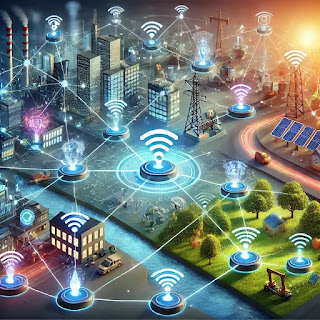Sensor networking refers to the deployment and integration of interconnected sensor nodes designed to collect, process, and transmit data within a network. These networks play a crucial role in monitoring and controlling physical environments by leveraging sensors to detect and respond to specific parameters like temperature, pressure, humidity, motion, or light.
Key Features of Sensor Networks:
Node Composition
- Each sensor node typically comprises:
- Sensing Unit: Captures environmental data.
- Processing Unit: Processes the data locally.
- Communication Module: Transmits data to other nodes or a central system.
- Power Source: Often reliant on batteries or energy-harvesting systems.
- Each sensor node typically comprises:
Data Transmission
- Nodes communicate wirelessly using protocols like Zigbee, Bluetooth, Wi-Fi, or LoRaWAN, depending on the network's requirements for range, energy efficiency, and bandwidth.
Topology
- Sensor networks can adopt various topologies such as star, mesh, or tree, depending on the application and scalability needs.
Self-Configuration
- Sensor networks are designed to configure and manage themselves dynamically, adjusting to changes like node failures or environmental shifts.
Applications of Sensor Networks:
Internet of Things (IoT):
- Smart homes, wearable devices, and connected appliances rely on sensor networks to deliver real-time data and automation.
Environmental Monitoring:
- Sensors monitor air quality, water quality, and climate conditions, aiding in research and disaster prevention.
Healthcare:
- Wearable health monitors and in-hospital networks track patient vitals for remote and real-time healthcare.
Industrial Automation:
- Used in predictive maintenance, inventory tracking, and machine health monitoring within smart factories.
Smart Cities:
- Applications include traffic management, waste monitoring, and smart lighting.
Defense and Security:
- Sensor networks enhance surveillance, intrusion detection, and disaster response systems.
Challenges:
- Energy Efficiency: Prolonging the lifetime of battery-powered nodes.
- Data Security: Protecting sensitive data from interception or manipulation.
- Scalability: Managing large, complex networks with thousands of nodes.
See more Info : network.sciencefather.com
Nomination: https://networking-events.sciencefather.com/award-nomination/?ecategory=Awards&rcategory=Awardee
Social Media :




No comments:
Post a Comment